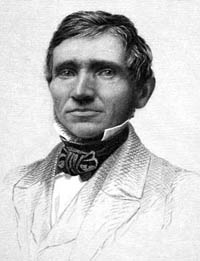 Charles Goodyear despite having no money, no knowledge of chemistry and only the crudest of tools, spent years experimenting with rubber. Prior to starting his experiments with rubber, Goodyear had a hardware business which went bankrupt. That was the beginning of many disastrous business attempts undergone by Goodyear. His first foray into inventing rubber products was not actually for rubber. Instead he invented a valve for inflating rubber life preservers. In 1834, he tried to sell his design to the Roxbury India Rubber Company in New York City. But on his visit there, he discovered that Roxbury India Rubber Company was on the verge of failing. Customers were returning life preservers because they were melting in the heat. The business was so bad and the failure such an embarrassment that a pit had been dug to bury failed products. The valve needed improving but the rubber was worse. Continue reading “Unfortunate Encounters of Goodyear: Improved Rubber Patent”
Charles Goodyear despite having no money, no knowledge of chemistry and only the crudest of tools, spent years experimenting with rubber. Prior to starting his experiments with rubber, Goodyear had a hardware business which went bankrupt. That was the beginning of many disastrous business attempts undergone by Goodyear. His first foray into inventing rubber products was not actually for rubber. Instead he invented a valve for inflating rubber life preservers. In 1834, he tried to sell his design to the Roxbury India Rubber Company in New York City. But on his visit there, he discovered that Roxbury India Rubber Company was on the verge of failing. Customers were returning life preservers because they were melting in the heat. The business was so bad and the failure such an embarrassment that a pit had been dug to bury failed products. The valve needed improving but the rubber was worse. Continue reading “Unfortunate Encounters of Goodyear: Improved Rubber Patent”

Category: Patent History
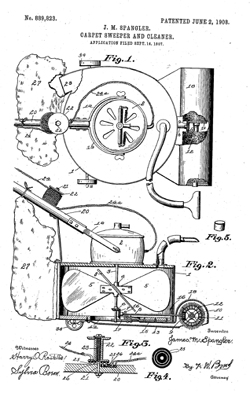 The first upright vacuum cleaner was invented by a janitor in Canton, Ohio. James Spangler was extremely prone to allergies and he was sure that his cough and asthma attacks were caused by the carpet sweeper he used at work. To alleviate this problem, he created a very basic suction sweeper. His device was just a box fan, a broom handle, a tin soap box and pillow case to collect dust. Despite being primitive and hard to use, the device did actually work. Spangler’s cough and asthma attacks lessened. Spangler continued to refine his “suction sweeper” and eventually applied for a patent. On June 2, 1908, he received US Patent Number 889,823 for a Carpet Sweeper and Cleaner.
The first upright vacuum cleaner was invented by a janitor in Canton, Ohio. James Spangler was extremely prone to allergies and he was sure that his cough and asthma attacks were caused by the carpet sweeper he used at work. To alleviate this problem, he created a very basic suction sweeper. His device was just a box fan, a broom handle, a tin soap box and pillow case to collect dust. Despite being primitive and hard to use, the device did actually work. Spangler’s cough and asthma attacks lessened. Spangler continued to refine his “suction sweeper” and eventually applied for a patent. On June 2, 1908, he received US Patent Number 889,823 for a Carpet Sweeper and Cleaner.
Spangler formed the Electric Suction Sweeper Company and began producing his machine. Production time was very slow though. With the help of his son and daughter, he was able to produce just 2-3 suction sweepers a week. One of these suctions sweepers was owned by his cousin, Susan Hoover. She was extremely impressed by the machine and told her husband W. H. “Boss” Hoover about the product. Continue reading “Box Fan, Soap Box, Pillow Case = Invention of the Vacuum Cleaner?”
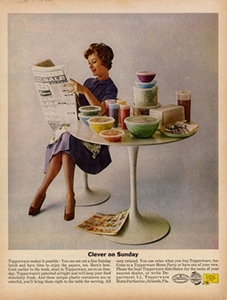 Earl S. Tupper envisioned himself a modern day Leonardo da Vinci. He was always dreaming up new inventions. He filled notebooks with his ideas which included an improved garter for stockings, permanent-press trousers, and a boat powered by fish. He even received several patents for shoe heals and a comb case. None of his ideas led to the success Tupper was hoping for until he began working with plastics.
Earl S. Tupper envisioned himself a modern day Leonardo da Vinci. He was always dreaming up new inventions. He filled notebooks with his ideas which included an improved garter for stockings, permanent-press trousers, and a boat powered by fish. He even received several patents for shoe heals and a comb case. None of his ideas led to the success Tupper was hoping for until he began working with plastics.
The Great Depression led to the bankruptcy of Tupper’s tree doctoring business. In order to make a living, he began working at a DuPont-owned plastics plant in Leominster, Massachusetts, Eventually his entrepreneur spirit led him to go back into business for himself. Tupper purchased some plastic molding machines and started Tupper plastics. At first, his new company produced cigarette cases and beads. Continue reading “Beads to Plastic Bowls – Invention of the Burping Seal”
Question from Andrew T:
How long has the snow blower been around for? Was it an accident like the snow machine?
Thanks Geek!!
– Andrew
Hello Andrew. I have been extremely thankful lately for the invention of the snow blower.
The invention was not an accident at all. It was invented by a Canadian man, Arthur Sicard, who was frustrated by the difficulty of delivering his milk from the farm to the market in the snow. The idea behind the snow blower came from a treshing machine. He utilized the same rotating blades on the tresher to blow the snow.
In 1925, Sicard was able to built a working, road clearing, snow blower. The Sicard Snow Remover Snowblower had three different sections, a four-wheel drive truck chassis and truck motor, the snow scooping section, and the snow blower with two adjustable chutes and separate motor. This machine could clear and throw snow over 90 feet from the truck or it could be put into the back of the truck. Sicard founded Sicard Industries to produce his machine. By 1927, the snow remover was being used to remove snow in areas around Montreal.
On Feb 26, 1929, Sicard was granted US Patent 1,703,786 for a snow-removing machine. You can view the patent here.
Have you ever wondered about the invention of your favorite toys? Every toy, every product, started as an idea somewhere. But whose idea was that Koosh Ball? Who designed that Rubik’s Cube that still has many of us stumped and frustrated?
The Koosh Ball
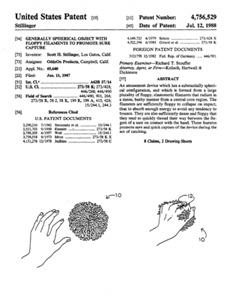 The Koosh Ball was developed in 1986 by Scott Stillinger. He was attempting to design a ball that would be easier for his 5-year old daughter and 8-year old son to hold and throw. The original prototype was made from rubber bands. Stillinger received US Patent 4,756,529 on July 12, 1988 for a generally spherical object with floppy filaments to promote sure capture.
The Koosh Ball was developed in 1986 by Scott Stillinger. He was attempting to design a ball that would be easier for his 5-year old daughter and 8-year old son to hold and throw. The original prototype was made from rubber bands. Stillinger received US Patent 4,756,529 on July 12, 1988 for a generally spherical object with floppy filaments to promote sure capture.
In order to market the product, Stillinger created OddzOn Products Inc with his brother-in-law who had been a marketing manager at Mattel. The product was one of the hottest toys to receive for Christmas in 1988. It is has been estimated that millions of the toy have been sold. Continue reading “Childhood Distractions: Invention of the Koosh Ball, Logs and Rubiks Cube”
Question from Cassie:
Happy New Year, Geek! I thought of this one over the Holiday. My daughter received a bunch of Shrinky Dink kits – I used to love them when I was little too (couldn’t believe they’re still around, either)! Anyway, I was wondering if there was a patent on these? They’re so unique I figured there must be…
– Cassie
Hello Cassie. I also loved those when I was little. They always seemed so magical.
Shrinky Dinks were invented as part of a Cub Scout project. In 1973, Betty Morris and Kathryn Bloomberg developed the craft with their sons. The first Shrinky Dinks were sold October 17, 1973 at the Brookfield Square Shopping Mall in Brookfield Wisconsin.
Despite seeming so amazing, there is actually no patent on the toy. The plastic sheets that shrink while getting thicker are actually polystyrene. This is the same polymer as recycled plastic #6. The manufacturing of polystyrene heats and rolls the polymer into thin sheets which are rapidly cooled. When the plastic Shrinky Dink sheets are put in the oven the heat cause the material to return to its original form. Matter and mass are not lost so the material shrinks in length and width and grows in thickness.
Polystyrene is a readily available and widely produced plastic so no patent could be filed for the magical Shrinky Dink toy. This doesn’t make the craft any less wondrous to watch as a child.
 The opening of the ski slopes is not completely in the hands of Mother Nature, and for that you can thank Dr. Ray Ringer. Ringer was not actually trying to invent a way to extend the ski season. His discovery of snowmaking is another happy accident.
The opening of the ski slopes is not completely in the hands of Mother Nature, and for that you can thank Dr. Ray Ringer. Ringer was not actually trying to invent a way to extend the ski season. His discovery of snowmaking is another happy accident.
Ray Ringer was working with other Canadian scientists to study the effects of rime ice on jet engines. An attempt to reproduce natural weather conditions lead to the discovery of how to make snow. The scientists were spraying water into the air of a low temperature wind tunnel right before a jet engine intake to create rime ice on the aircraft. Instead of creating ice, they kept making snow. The jet engines and the wind tunnel had to be shut down regularly to shovel away the powder. Continue reading “Slopes All Day: Invention of the Snow-making Machine”
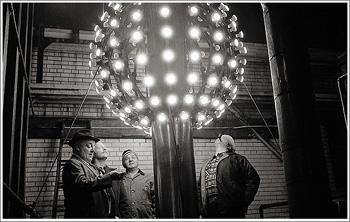 The famous Times Square time ball is one of the most iconic players in the tradition of ringing in the New Year. For over 100 years, millions have gathered together in New York City to celebrate its decent.
The famous Times Square time ball is one of the most iconic players in the tradition of ringing in the New Year. For over 100 years, millions have gathered together in New York City to celebrate its decent.
The first New Year’s Eve Ball in Times Square was dropped in 1907. Owner of The New York Times, Adolph Ochs, wanted to create a New Year’s Eve midnight show to draw attention to Time’s Square. Chief electrician for the Times constructed a 700-pound, 5-feet in diameter ball of iron and wood with 100 25-watt bulbs for this shows. Continue reading “Happy New Year! Invention of the New Year’s Eve Ball”
The likeness of Santa Claus has been patented for use on everything from pasta to flashlights. There is even a design patent on just Santa’s foot. Below are some patents in honor of Santa Claus and Christmas.
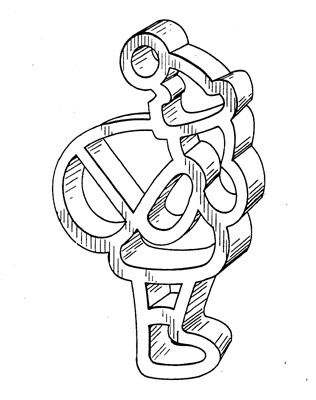
Santa Shaped Pasta
Patent number: D333546
Filing date: Jun 21, 1991
Issue date: Mar 2, 1993
Assignees: Kraft General Foods, Inc.
Continue reading “Santa Claus Patents: Pasta, Pins, Lighters and a Foot”
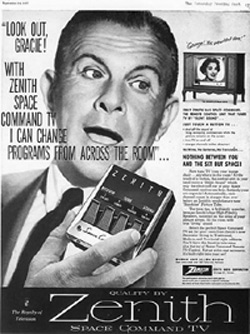 We can all thank Robert Adler for the ability to be complete couch potatoes while watching TV. Born December 4, 1913, Robert Adler held 180 patents for electronic devices but he is best known for having invented the first useable wireless television remote control.
We can all thank Robert Adler for the ability to be complete couch potatoes while watching TV. Born December 4, 1913, Robert Adler held 180 patents for electronic devices but he is best known for having invented the first useable wireless television remote control.
The first remote control known as “Lazy Bones” was developed in the 1950’s by Zenith. This remote used a cable that ran from the TV to the user. An idea for a wireless remote control was devised by fellow Zenith engineer Eugene Polley. This remote control used light beams to control the television. The problem was that when the television was in direct sunlight it would often turn on by itself. Continue reading “Nothing Between You and the TV But Space!”
